
views
Learning the Basic Rules
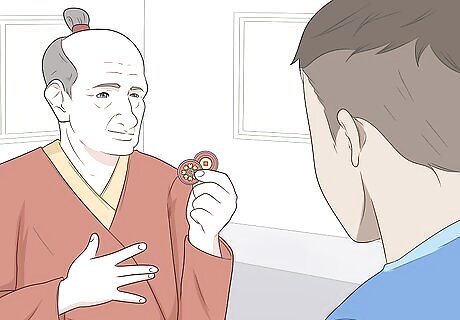
Find 1 other person to play with. Because of the way the board is designed, Pai Sho can only be played by 2 players. If you know someone who enjoys strategy-based board games, invite them to join you in a couple of rounds. To get other players in on the action, consider holding a Pai Sho tournament or playing a series of games with a “winner stays” format. If you’re playing an online version of the game, such as the popular Skud Pai Sho, you have the option of either starting a game with a friend or squaring off against the computer. You can play Skud Pai Sho for free online. Pai Sho is a fun, intelligent, challenging game that anyone can enjoy, not just fans of Avatar or Korra.
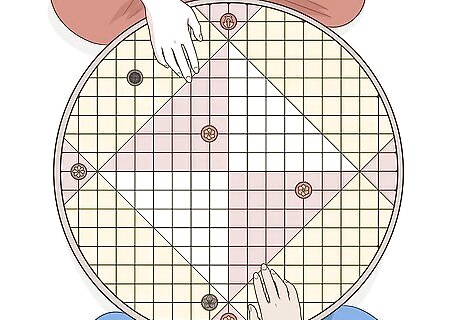
The object of the game is to form Harmonies. In a game of Pai Sho, players take turns arranging various tile pieces to form “Harmonies.” A Harmony is formed when a player places 2 harmonious flower tiles in an uninterrupted line along any of the board’s intersecting lines. The first player to successfully create a predetermined number of Harmonies on the board is the winner. While it is possible to capture your opponent’s tiles in Pai Sho, the idea behind doing so is to keep them from forming harmonies rather than to collect the pieces themselves. In Skud Pai Sho, the object is to create an unbroken “Harmony Ring” that encircles the center of the board.

Familiarize yourself with the layout of the board. Pai Sho is played on a large, circular board containing 256 individual square spaces, which make up 12 different sections of various sizes. At the center of the board is a diamond-shaped section divided into 4 quadrants, 2 white and 2 red, arranged opposite one another. Physical fan-made replicas of the game are also available for purchase online. These typically range in price from $30-200, depending on the size and quality of the materials used.Tip: If you’re the crafty type, you could also try making your own custom board using materials like wood, cardboard, and paint or colored markers.
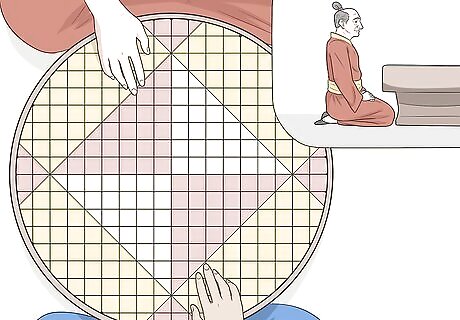
Sit down at the board facing one of the 4 small red triangles. These triangles are known as “Gates.” There are a total of 4 Gates on the board, one for each of the primary directions. The Gate closest to you is your “home” Gate, while the Gate closest to your opponent is the “foreign” Gate. When you and your opponent are positioned properly, you should each have an open Gate to your right and left. Every time you add a new piece to the board during gameplay, you must start it inside one of the 4 Gates.
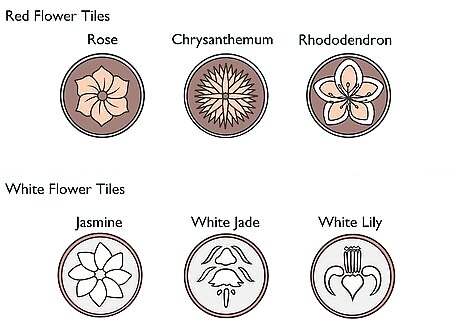
Learn how the Basic Flower tiles move on the board. Pai Sho is played using a total of 108 circular tiles (54 for each player), which have symbols that indicate how they move and interact with other tiles on the board. The Basic Flower tiles are the game’s primary movement pieces. They’re broken up into 2 groups: White (Jasmine, Lily, White Jade) and Red (Rose, Chrysanthemum, Rhododendron). Jasmine (or White 3): Move up to 3 spaces. Harmonious with Rhododendron and Lily. Clashes with Rose. Lily (or White 4): Move up to 4 spaces. Harmonious with Jasmine and White Jade. Clashes with Chrysanthemum. White Jade (or White 5): Move up to 5 spaces. Harmonious with Lily and Rose. Clashes with Rhododendron. Rose (or Red 3): Move up to 3 spaces. Harmonious with White Jade and Chrysanthemum. Clashes with Jasmine. Chrysanthemum (or Red 4): Move up to 4 spaces. Harmonious with Rose and Rhododendron. Clashes with Lily. Rhododendron (or Red 5): Move up to 5 spaces. Harmonious with Chrysanthemum and Jasmine. Clashes with White Jade.

Understand the role of the Accent and Special tiles. The remaining 18 tiles include 12 “Accent” tiles (Rock, Wheel, Knotweed, Boat) and 6 Special tiles (White Lotus, White Dragon or Orchid), which have their own signature abilities and uses. You can only play one of these tiles during a Harmony bonus, which you’ll be rewarded with any time you create a new Harmony. Rock: Cancels Harmonies along any lines it's placed on. You can place this tile at any open intersection on the board. Once a Rock tile has been planted, it can’t be captured or moved, even by a Wheel. Wheel: Rotates all adjacent and diagonal tiles 1 space in a clockwise direction around it. You can place this tile at any open point, except where it would move a Rock tile, cause tiles to clash, or move a tile to an opposite-colored garden, off the board, off of a gate, or onto a gate. Knotweed: Cancels Harmonies in surrounding adjacent spaces by “choking” or “draining” the flower tiles. If you’re playing on a physical board, flip the affected tiles over to show that they’ve been neutralized. You can place this tile at any open point on the board. Boat: Either moves a Flower tile to an empty adjacent or diagonal space (taking that tile’s place in the process) or removes an opponent’s Accent tile from the board. You can only play this on a Flower tile moved outside of the Gate or an Accent tile. White Dragon or Orchid: Removes active tiles from the board if it lands directly on them. You can place this tile at any open point on the board and move it in 6 spaces in any direction on each turn. White Lotus: Turns Harmonies into Disharmonies and Disharmonies into Harmonies. You can place this tile at any open point on the board and move it up to 2 spaces in any direction on each turn.
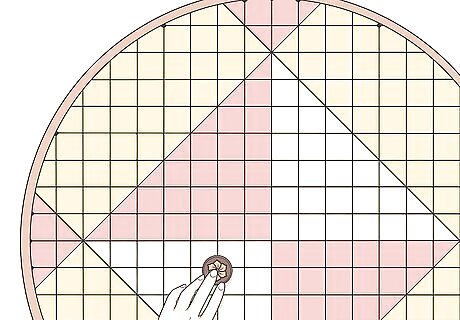
Make sure you’re clear about what moves you can and can’t make. For example, you’re only permitted to move your main Flower tiles into a Garden of the opposite color. The “Gardens” are the colored quadrants in the diamond at the center of the board. A white tile can only pass through a red garden, and a red tile can only pass through a white garden. One of your tiles can’t occupy the same space as one of your opponent’s tiles. The only exception to this rule is in the case of the Boat and White Dragon (or Orchid) tiles, which take the place of another tile. Additionally, you’re not allowed to move any tile onto any of the Gates on the board. These sections are off-limits except for new pieces that are introduced to the board, or “Planted.”
Setting up the Game
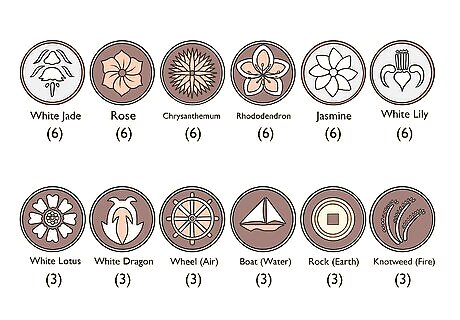
Deal out 54 tiles of the correct suit to each player. At the beginning of the game, each player will receive 54 tiles. These will include 36 basic flower tiles—6 Jasmine, 6 White Lily, 6 White Jade, 6 Rose, 6 Chrysanthemum, and 6 Rhododendron. Each player will also get 18 Accent and Special tiles—3 Rock, 3 Wheel, 3 Knotweed, 3 Boat, 3 White Dragon, and 3 White Lotus. Count your tiles carefully as you deal to make sure that both players end up with the same number of each. Otherwise, the game won’t proceed fairly.

Specify a number of tiles for both players to keep in their hand. Place your remaining tiles into a bag or similar blind container and keep it close by. As you play, you’ll draw new tiles from the bag at random to replenish your hand. Every time you put a new tile into play on the board, you’ll grab a fresh tile from your reserve stock. No player is to ever have more than the designated number of tiles in their hand at any point during the game.

Decide on a target number of Harmonies to play for. The first player to reach your agreed-upon number of Harmonies wins the game. 10 Harmonies is a standard goal for newer players. However, you could choose any number you like, provided there are enough tiles to form the necessary arrangements. Keep in mind that the greater your target number of Harmonies, the longer it will take to finish the game. Pai Sho can be time-consuming, so setting too high a number could cause your game to feel never-ending.Tip: Choosing a small number of Harmonies, like 3 or 5, will make for a faster-paced, more competitive game. In Skud Pai Sho, you don’t pick a number of Harmonies. Instead, the game ends when a player creates a ring of Harmonies around the center point of the board.
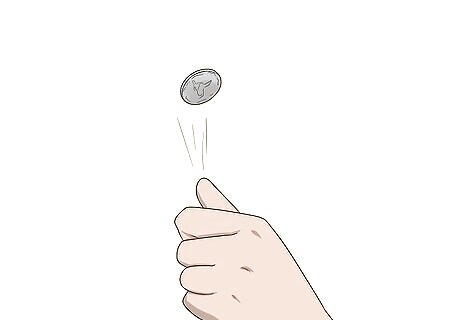
Flip a coin to determine which player gets to make the first action. The winner of the coin toss is the starting player, who receives the title of “Guest.” The guest starts by placing any Flower tile of their choosing inside their home Gate. The other player then sets up the same kind of tile within their home Gate. If you want to up the stakes a little, the guest can win an early advantage by both planting the first tile and taking the first turn. In some versions of the game, the guest gets the privilege of placing a tile on the midgate at the board's center.
Playing Strategies
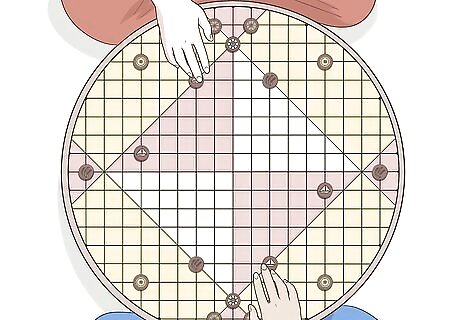
Use your first few turns to add new pieces to the board. Once you’ve determined your play order, you’ll begin alternating turns, similar to a game of chess or checkers. During a turn, you have the option of either “Planting” or “Arranging.” “Planting” is when you put a new tile into play by placing it in an open Gate. Any time you add a tile to the board, you must start it inside an open Gate. Depending on what version you play, different tiles might originate in different gates.Tip: If you want to make things a little more interesting, there's also a version of the game where each turn gives the player a chance to either discard a tile from their hand and draw a new tile or plant and arrange a tile (or 2 separate tiles) within the same turn.
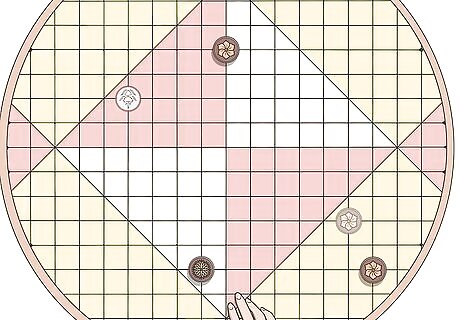
Arrange the tiles you have on the board to try to form Harmonies. 2 tiles form a Harmony when they’re harmonious with each other (i.e. White Lily and Jasmine) and there aren’t any clashing tiles or Gates between them. A single Flower tile can be used to form 2 separate Harmonies, as long as they’re on different parallels. In Pai Sho, the pieces are played at the points where 2 board lines meet rather than inside the spaces themselves. In Iroh Pai Sho, Harmonies can’t be formed diagonally or along any of the board’s key mid-lines, which run through the center of the board in an imaginary cross shape. If you’re playing Skud Pai Sho, your harmonies highlight on the screen to help you keep track of them.
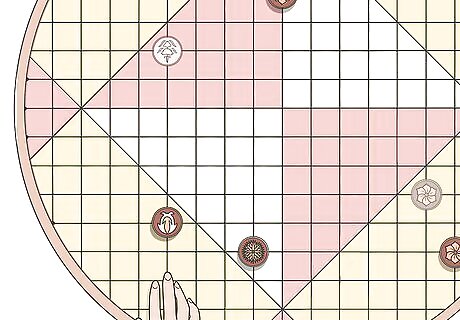
Play an Accent or Special tile each time you form a new Harmony. For each Harmony you put together, you’ll have the chance to add an Accent tile to the board without waiting for your next turn. If you don’t have any Accent tiles remaining, you can plant one of your Basic Flower tiles instead. Harmony bonuses will help you thwart your opponent and bring you that much closer to your next harmony. You only have half the number of accent tiles in your bag that you do basic flower tiles, so use them wisely.
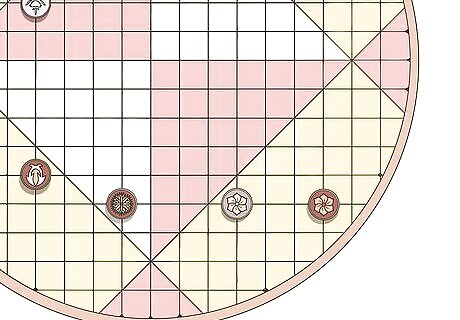
Disrupt your opponent’s Harmonies to prevent them from winning. If your opponent has just formed a Harmony, or you see that they’re about to, try to arrange your tiles in a way that blocks them or breaks them up. This can be accomplished by moving a clashing tile in between the 2 harmonious tiles to create a Disharmony, or by using one of your Accent tiles’ special abilities during Harmony bonuses. It’s possible to form a Harmony of your own with a tile that’s being used to disrupt one of your opponent’s harmonies. The configuration of the board will change constantly, so try not to get discouraged if you’re trailing your opponent in Harmonies.
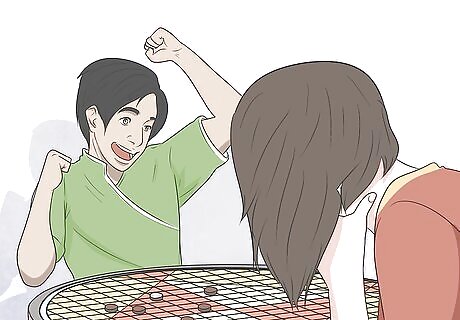
Continue playing until one player reaches the target number of Harmonies. Be sure to call out when you think you’ve won so you and your opponent can stop and survey the board together. If you’re playing Skud Pai Sho, don’t forget that you must create a “Harmony Ring” that crosses each of the board’s midlines to gain victory. It can be tough to keep track of how many unbroken Harmonies you have on the board when you’re focused on your next move. It may be helpful to pause periodically to look over the board and make sure you or your opponent haven’t missed anything. In Ancient Pai Sho, the player who’s behind has 1 turn to disrupt their opponent’s harmony ring once it’s been completed. If they fail to do so, they lose the game.
Key Pai Sho Alternate Rules
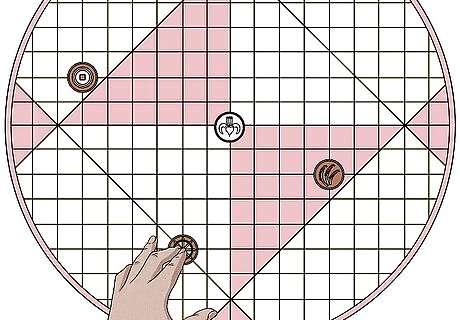
Key Pai Sho is a version that accurately reflects the game in the show. In the Original Series, Pai Sho did not have a disclosed ruleset, and versions created since have not necessarily reflected the game in the show. To address this, passionate fans have created a version of the game that imitates every move and shot shown in Avatar: the Last Airbender. This version was designed not only to imitate the portrayal shown in the Original Series but also to utilize existing tiles and mechanics that have been incorporated into the most popular versions of the game, making it accessible for those who own Pai Sho sets. Like most versions of the game, it is for two players and can be played online through the Garden Gate Community at Skud Pai Sho.
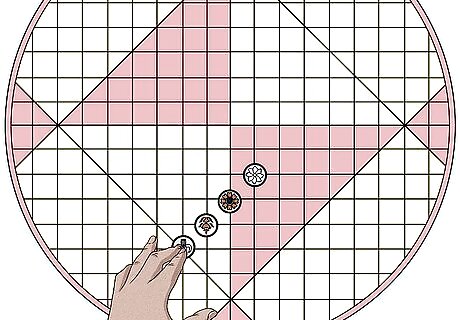
The objective is to form at least 4 Flower “Harmonies” around the center. A Harmony is an invisible line formed between two of a player’s Flowers. There are 4 important rules concerning Flower Harmonies: They form when one of a player’s Flower tiles lies in a potential movement path of one of their Key Flower tiles. They are “Blocked” if an opponent’s Flower tile is between the two Flowers attempting to Harmonize. There needs to be at least one open space between harmonizing Flowers. Harmonies cannot form between Key Flowers of the same type.
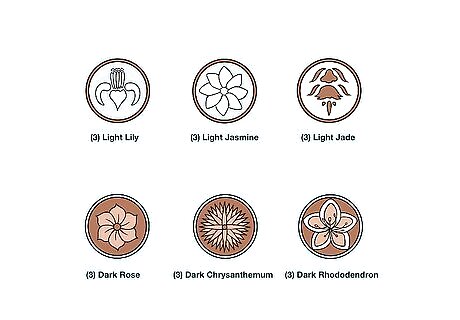
Key Flower tiles are the main tiles players use to form Harmonies. There are 6 Key Flowers: 3 Light (Lily, Jasmine, and Jade) and 3 Dark (Rose, Chrysanthemum, and Rhododendron). Each Player begins a game with 3 of each of these flowers. Key Flower tiles have different movement abilities based on their type – and these potential movement paths also determine how each Flower can Harmonize: Lily and Rose tiles can each move and harmonize up to 3 steps per turn vertically, horizontally, or diagonally. Jasmine and Chrysanthemum tiles can each move and harmonize up to 5 steps per turn, either vertically or horizontally. Jade and Rhododendron tiles can each move and harmonize up to 5 steps per turn diagonally.
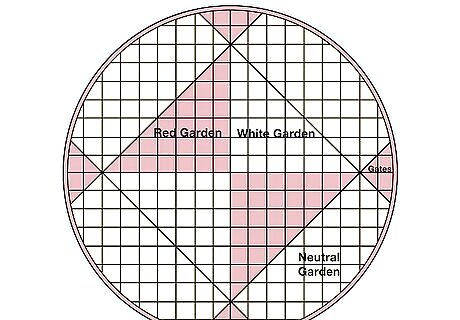
Understanding the Key Pai Sho board. The Pai Sho board has a unique design and is divided up between ‘Gates’, the 4 triangles around the edges of the board, and ‘Gardens’, the rest of the squares on the board. Gardens come in 3 types: Light, the fully White Squares, Dark, the fully Red Squares, and Neutral, all other squares that are neither fully Light nor fully Dark. Gates are where Flower tiles are “Planted,” when first placed on the board. They can start their first movement in any of the squares surrounding the Gate, as indicated by Blue. Key Flower tiles are either Light (white) or Dark (Red). Light Key Flowers can never land in Dark Garden Squares and Dark Key Flowers can never land in Light Garden Squares. However, all flowers can move through Gardens of the opposite color.
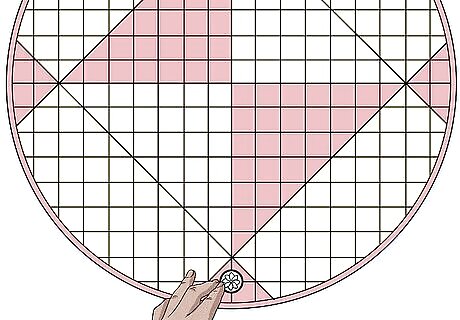
Playing Key Pai Sho. Players take turns, and in each turn, a player can either “Plant” a new Flower tile into a Gate, or move a Flower tile that is already on the board. (A player may have a maximum of 2 Planted Flower Tiles at any given time.) The first player to create an unbroken chain of at least 4 Harmonies around the center of the board claims victory! In addition to these basic rules, 12 Special and Accent)tiles add elements of creativity and surprise to the game.
Special Flower and Accent Tiles in Key Pai Sho

Effect Tiles are either Special Flower Tiles or Accent Tiles. Before the game begins, each player selects 6 of the 12 possible Accent Tiles to use for the duration of that game and cannot change their selection after the game has begun. Special Flower Tiles act much like Key Flowers—they need to be planted in Gates before moving into the Garden. However, each has a unique ability that can be employed to assist your play strategy. Instead of being “Planted” in Gates, Accent Tiles are placed in the Garden by switching them with one of the player’s Flower tiles that are already in a Garden square. The Accent tile is placed in the square that the Flower previously occupied, and the Flower returns to its player’s collection to be re-used later. Each Accent tile has a unique effect on the game. A player can place 1 Accent tile per turn at any point. Accent Tiles are the only ones capable of moving over other Tiles.
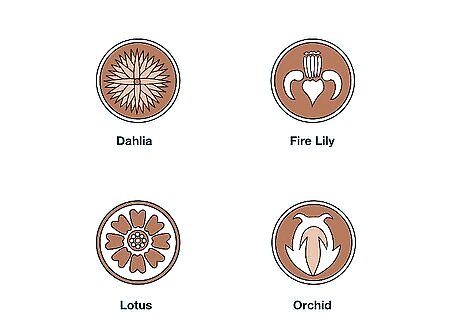
Special Flower tiles There are 4 Special Flower Tiles, each with their own movement capacities and special abilities: Lotus: Ignores all usual Harmony rules and harmonizes over any distance with either player’s Flower Tile. This tile can therefore be used by either player to complete their Harmony Ring. It can move up to 2 steps in a turn in any direction. Orchid: If a Player moves the Orchid Tile during their turn, they are allowed one additional move that same turn. It can move 1 step in any direction per turn. Dahlia: The Dahlia can move any distance vertically, horizontally, or diagonally, and can move over other tiles. However, it must always land beside another tile already in the Garden. Fire Lily: The Fire Lily cannot form Harmonies (except with the Lotus), but it only blocks the opponent’s Harmonies. It can move 6 steps in a turn, with each step being in any direction.Opening the Garden Gate: The Lotus Tile has a unique technique that it can employ: If the center four Garden squares are empty, it can be planted in the center of the board, turning those four squares into a Gate. However, its player has to move it out during their following turn, with its first step being counted in any of the center 4 squares.
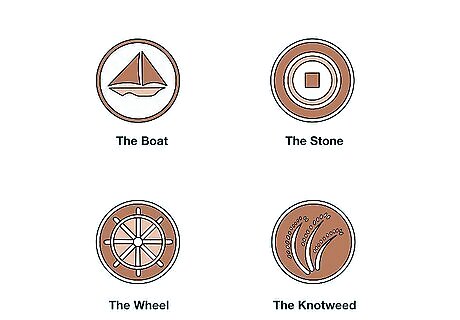
World Object Accent tiles The first four Accent Tiles are based on inanimate objects – the Stone, the Knotweed, the Wheel, and the Boat. Remember, these tiles are placed by switching them with tiles in the Garden, not by planting them. Stone: Can be placed anywhere in the Garden after switching with a Flower, not only in the Flower’s square. It’s unable to move by itself. It allows all of its player’s Key Flowers to enter any square in its quarter of the Garden, ignoring whether the Garden is Dark or Light. Knotweed: All surrounding Flowers are rendered unable to move themselves or to harmonize as long as they are beside the Knotweed (this affects Flowers belonging to either player). The Knotweed can move up to 2 steps per turn, whether vertically, horizontally, or diagonally. Wheel: Must be placed by switching with another Accent tile, not a Flower tile, allowing that Accent tile to be recycled. Once per turn, the Player can rotate all surrounding tiles up to 3 squares clockwise or counter-clockwise. All surrounding tiles must rotate the same amount and must be capable of landing in the final square of the Wheel effect’s motion. The Wheel can move up to 3 steps per turn, whether vertically, horizontally, or diagonally. Boat: When the Boat tile moves, it can activate its effect and carry all surrounding Tiles with it, placing them in the same positions relative to it at the end of its motion. All tiles must be able to land effectively in the final positions to use this effect. The Boat can move up to 4 steps per turn, whether vertically, horizontally, or diagonally.

Elemental Accent tiles The final 4 Accent Tiles are based on the Original Elemental Benders from the Avatar Universe – the Badgermole, the Dragon, the Skybison, and the Koi (Ocean and Moon Spirits). These are all placed by switching them in for one of their Player’s Flowers in the Garden. All 4 of these Accent Tiles can move up to 5 steps per turn, whether vertically, horizontally, or diagonally. The Dragon: Can land on another tile to return it to its player to be reused later. However, any Effect tile can land on the Dragon to completely remove it from the game. Once removed, it cannot be used again for the duration of that game. The Badgermole: Can land on a tile and be placed underneath it. When below a tile, the above tile is completely unaffected by Accent tile effects. The Badgermole can move while under a tile and may carry the above tile with it as it goes. The above tile can be moved off the Badgermole by its player. The Skybison: The Skybison can land on a tile and be placed beneath it. When below a Flower, the above tile cannot have its Harmonies blocked by opposing Flower tiles. The Skybison can move while below a tile and may carry the above tile with it as it goes, and once it has finished moving, the tile that it carried may make an additional move, off of the Skybison. The Koi: The Koi tile can swap the position of tiles on opposite sides of it (vertically, horizontally, or diagonally). If they are in line and the Koi is between them, their positions can be switched, but only if both tiles can land in the other’s square (e.g. Light Flowers cannot land in Dark Gardens).



















Comments
0 comment